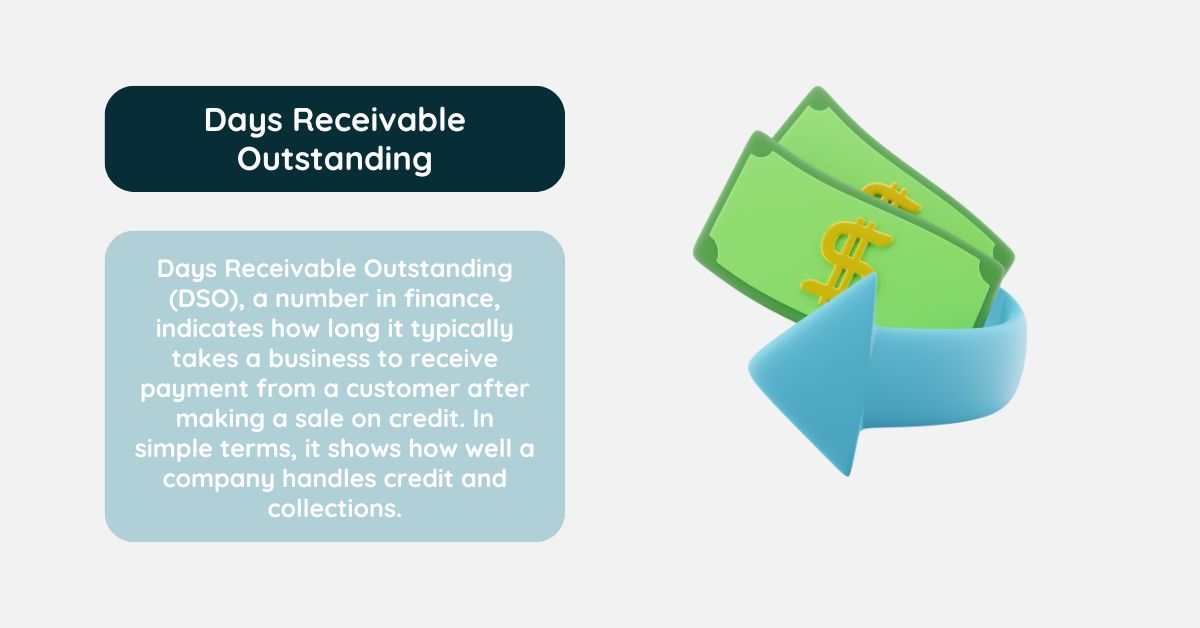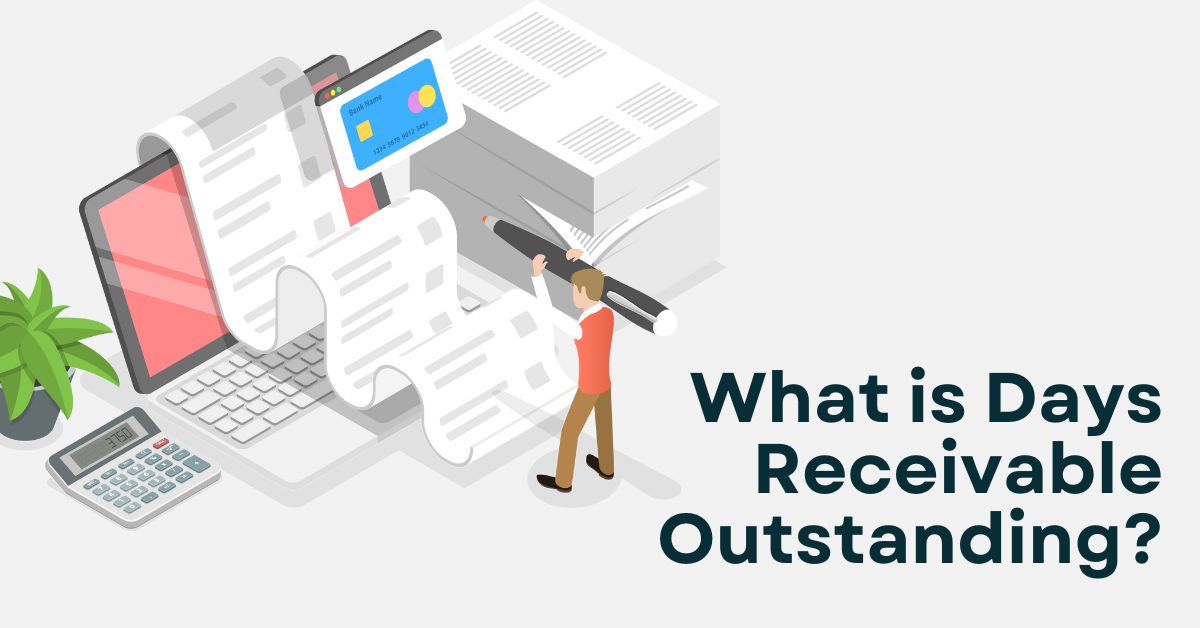Cash flow is crucial in the fast-paced business world. Days Sales Outstanding (DSO) is an important measure that can have a big effect on your business’s finances. You can improve your bottom line and your sales cycle if you understand DSO.
What is Days Receivable Outstanding?

Days Receivable Outstanding (DSO), a number in finance, indicates how long it typically takes a business to receive payment from a customer after making a sale on credit. In simple terms, it shows how well a company handles credit and collections.
A low DSO indicates that the company is receiving payments more quickly. If it’s high, it means that funds are coming in more slowly, and there may be cash flow problems. DSO is an important metric for companies because it has a direct effect on their cash flow and general health.
Formula of Days Receivable Outstanding
The formula for Days Sales Outstanding (DSO) is:
DSO = (Average Accounts Receivable / Net Credit Sales) x Number of Days
Here’s a breakdown of the components:
- Average Accounts Receivable: This is the average amount of money that people owed the business during a certain time period. To find it, add the amounts of receivables at the beginning and end of the period and divide by 2.
- Net Credit Sales: This is the total amount of credit sales made during the period, excluding any returns, discounts, or allowances.
- Number of Days: This refers to the number of days in the chosen time frame, such as 365 for a year or 90 for a quarter.
By locating the DSO, you can determine how well a business is receiving payments from its customers. You can also see where its credit and collection methods could be better.
When is a High or Low DSO Indicated?
A low DSO typically indicates that a business is effectively collecting payments from its customers. This means the company is getting cash quickly, which is beneficial for its cash flow and overall health. A low DSO usually means that you have excellent credit and collection methods, that you bill customers on time, and that you communicate well with them.
On the other hand, a high DSO indicates that customers are taking longer to pay a business.
The company may have to wait longer for its money, hurting cash flow. Various factors such as slow billing, ineffective collection methods, easy credit terms, or customer payment issues could lead to a high DSO.
It’s important to remember that the best DSO is different for each company and industry. A smaller DSO is usually better, though, because it means better cash flow management and better financial health.
How to Lower Days Sales Outstanding
Companies can use a number of different methods to lower Days Sales Outstanding (DSO). To begin, they can make billing more efficient by sending bills on time and correctly. Second, giving benefits for early payment can encourage people to pay earlier. Third, establishing clear and strict credit terms can aid in timely payment.
Fourth, automating the process of collecting debts can make things run more smoothly and take less time. Lastly, positive contact with customers about when payments are due and what might happen if they are late can also help lower the DSO.
Applications of Days Sales Outstanding
Days Sales Outstanding (DSO) is a versatile metric that finds application in various aspects of business management and financial analysis.
1. Checking the Health of Your Money:
- Cash Flow Analysis: DSO has a direct effect on the cash flow of a business. A lower DSO means faster cash flow, which is important for paying for operations, investing in growth, and keeping up with loan payments.
- Liquidity Assessment: When the DSO is low, the company has better access to its working capital, which makes its liquidity greater.
2. Comparisons and benchmarking within an industry:
- Industry Standards: To determine how well a company is performing in comparison to its peers, compare DSO to standards in the same industry.
- Identifying Inefficiencies: When you compare DSO to past data, you can find trends and possible ways to make the credit and recovery processes better.
3. Credit and Collection Management:
- Customer Segmentation: By grouping customers according to their payment methods, DSO enables more focused collection efforts.
- Credit Policy Review: Looking at DSO can help you figure out how well credit policies are working and find chances to make credit terms stricter or softer.
- Collection Strategy Optimization: Companies can improve their collection strategies by learning about the factors that affect DSO. For example, they could make payment terms stricter or buy collection tools that work better.
4. Strategic Decision Making:
- Pricing and Sales Strategies: DSO can help you decide how to set prices and terms of sales so that you can balance cash flow and revenue growth.
- Prioritizing investments: A smaller DSO can free up funds for growth or other crucial strategic objectives.
Businesses can learn a lot about their financial health and performance by using DSO correctly. They can find ways to improve their cash flow and general financial health and make smart decisions based on this information.
Limitations of Days Sales Outstanding
Days Sales Outstanding (DSO) is a useful way to figure out how healthy a company’s finances are, but it has some flaws:
- DSO ignores cash sales, only counting credit sales. This can make it challenging to see how well a company is collecting generally.
- Industry Differences: The debt service obligations (DSO) vary significantly across businesses. It can be wrong to compare DSO between businesses that have different credit policies and payment terms.
- Seasonal Variations: Because sales cycles and payment habits change with the seasons, it can be challenging for seasonal businesses to figure out what the trends mean.
- Accounting Methods: Various accounting methods can alter the calculation of accounts payable and net credit sales, thereby affecting the accuracy of DSO.
- External Factors: The economy, industry trends, and customer behavior are among the many factors that affect DSO. This makes it difficult to tell how a company’s internal policies and processes affect DSO.
- Oversimplification: While DSO provides an overview of the average collection time, it does not consider the distribution of payment delays. It may hide problems with slow-paying customers or old debts.
To get around these problems, it’s important to use DSO with other financial measures and take into account how a company’s business works. Examining changes in DSO over time and comparing them to industry standards can also provide a more accurate picture of a company’s credit and collection success.
Days Sales Outstanding vs. Average Collection Period
| Feature | Days Sales Outstanding (DSO) | Average Collection Period (ACP) |
|---|---|---|
| Definition | It measures the average number of days it takes a company to collect payment after making a sale on credit. | It also gauges how long it typically takes a business to obtain payment following a credit sale. |
| Calculation | (Average Accounts Receivable / Net Credit Sales) x Number of Days | (Average Accounts Receivable / Average Daily Credit Sales) |
| Focus | The company primarily focuses on credit sales. | We can consider both credit and cash sales. |
| Interpretation | A lower DSO is generally better, indicating efficient collection processes. | A lower ACP is generally better, indicating efficient collection processes. |
| Key Difference | DSO specifically considers net credit sales, while ACP can incorporate both credit and cash sales, providing a broader view of overall collection efficiency. |
What Is a Good DSO Ratio?
What is a “good” DSO ratio depends on the business and the market. While there are variations, a DSO of 45 days or less is usually acceptable for most companies. This indicates the smooth operation of the payment process and effective management of the cash flow.
Keep in mind that standards can vary by business. For example, DSOs may be higher in manufacturing or building, where payment terms are longer, but they are still considered acceptable.
It is important for businesses to compare their DSO to industry standards, past trends, and their own financial goals in order to figure out what a beneficial DSO is for them. Looking at the things that affect DSO, like credit policies, billing practices, and how customers pay, can also help you find ways to improve things and make the most of your cash flow.
If you want to read about cash flow in detail, you can read here:
- What is Cash Flow Statement? Understanding Your Business’s Financial Lifeline
- What is Free Cash Flow? A Clear and Concise Definition
How is DSO Calculated in 3 Months?
To calculate DSO for a 3-month period, you can use the following formula:
DSO = (Average Accounts Receivable / Average Monthly Credit Sales) * 90
Here’s how to break it down:
-
Calculate Average Accounts Receivable:
- Add the beginning and ending accounts receivable balances for the 3-month period.
- Divide the sum by 2.
-
Calculate Average Monthly Credit Sales:
- Add the total credit sales for each of the 3 months.
- Divide the sum by 3.
-
Plug the values into the formula:
- Use the calculated average accounts receivable and average monthly credit sales in the DSO formula.
- Multiply the result by 90 (the number of days in 3 months).
Example:
- Beginning Accounts Receivable: $100,000
- Ending Accounts Receivable: $120,000
- Total Credit Sales for 3 Months: $360,000
Calculations:
- Average Accounts Receivable = ($100,000 + $120,000) / 2 = $110,000
- Average Monthly Credit Sales = $360,000 / 3 = $120,000
DSO Calculation:
- DSO = ($110,000 / $120,000) * 90 = 82.5 days
In this example, the company takes, on average, 82.5 days to collect payment from its customers.
Why Calculate Days Sales Outstanding?
Businesses need to figure out their Days Sales Outstanding (DSO) to see how well they are doing financially and how efficient they are. Businesses can improve their credit and recovery processes by understanding the average customer payment duration. A lower DSO means that cash flow is working well, there is more cash on hand, and there is less chance of negative debts.
On the other hand, a higher DSO could mean that there are problems with cash flow, slower payment cycles, or credit practices that don’t work as well. By monitoring and analyzing DSO, businesses can make informed decisions on how to enhance their processes, improve customer interactions, and increase overall revenue.

